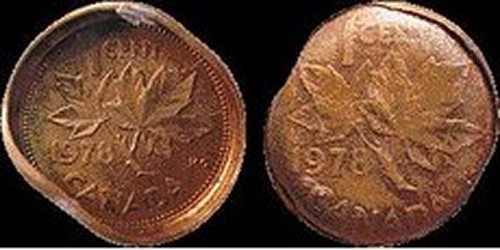‘Two-tailed’ Canadian cents: mules or pseudo-mules?
By Mike Diamond-Special to Coin World |
March 10, 2012 9:58 a.m.
Article first published in 2012-03-19, Expert Advice section of Coin World
This multi-struck, double-reverse Canadian cent takes the form of a die cap. It could be a two-tailed mule (struck by two reverse dies) or a pseudo-mule.
Images by Mike Diamond.

On page 197 of World’s Greatest Mint Errors (Zyrus Press, 2009), author Mike Byers features a multi-struck 1978 Canadian cent with the reverse design on both faces. The extra strike(s) transformed the coin into a die cap with impressively high walls (see photos).
These details are beyond dispute. What can be questioned is the coin’s status as a two-tailed mule. A mule is a coin struck by mismatched dies. Both Byers and Professional Coin Grading Service state that the coin was struck by two reverse dies, one acting as hammer die and one as the anvil die.
It’s important to note that ordinary Canadian cents are invariably struck with the reverse die acting as the hammer die (the hammer die delivers the impact while the anvil die receives the impact).
Possible pseudo mule?
There’s another, equally plausible diagnosis — that this is a two-tailed pseudo-mule (false mule). Despite carrying the same design on each face, a pseudo-mule is struck using a conventional die setup. The 1978 Canadian cent’s current owner, Chef Ito, sent it to me after I mentioned this possibility.
se events can occur spontaneously or with human assistance. Regardless of its etiology, I strongly suspect that Ito’s coin had help. In 1978 a flood of highly improbable errors emerged from the Royal Canadian Mint, many bearing the cent design.
Dia
A pseudo-mule incorporating the maple leaf design on each face can be created in several ways.
(1) A cent is struck normally, flips over, and lands on top of another planchet. A second strike flattens the original Maple Leaf design while the queen’s bust is obliterated. The double thickness, and the associated increase in effective striking pressure, facilitates complete erasure of the bust.
(2) Two planchets are struck together within the collar, creating two in-collar uniface strikes. In other words, each coin has a blank face. The bottom coin is ejected, while the top coin flips over and lands on another planchet. The original Maple Leaf design is flattened, while the original featureless surface is struck by the hammer die.
(3) A cent sporting an in-collar first-strike brockage of the Maple Leaf design on its bottom face flips over (a brockage is an incuse, mirror-image version of the design). Another planchet is fed on top of the brockaged coin and is struck into it. The bottom face of that newly-struck coin carries a first-strike counterbrockage of the Maple Leaf design.
The
gnosis uncertain
Despite careful study, I was unable to determine if Ito’s coin is a mule or a pseudo-mule. Based on appearance alone, both scenarios seem equally plausible. But from the standpoint of process, a pseudo-mule would seem more likely. Chris Pilliod explained why in an Oct. 2, 2000, Coin World article on a two-headed 1859 Indian Head cent. In most presses, the anvil die has a longer neck than the hammer die. This allows the anvil die to move up and down within the collar and bring the newly-struck coin into the path of the ejection finger. A hammer die installed in the anvil die’s position could not perform this function and, more importantly, could not bring a planchet within range of the properly installed hammer die for a strike.
For a hammer die to act as an anvil die, you need to machine a longer neck. That requires time, equipment, expertise and most problematically, a wider conspiracy. One press operator, working quickly, can create an intentional pseudo-mule. This is probably why all Malaysian double-obverse 1-sen coins show the diagnostic characteristics of a double-struck pseudo-mule (see Feb. 8, 2010 and April 25, 2011, issues of Coin World).
Other Canadian rarities
Two other double-reverse Canadian cents (1980) have been reported (Coin World, Oct. 1, 2001). Both were described and encapsulated as mules. However, both coins show features consistent with a pseudo-mule (see photos of one of the examples, to the left).
(1) One face (“side A”) is sharply struck while the other (“side B”) shows flatter relief and softer details. PCGS reported side B as being “rougher in appearance” while Superior Galleries described a “frosty” surface texture. Both organizations thought Side B was struck by a worn die. However, these attributes are wholly consistent with a second strike against a planchet. Such impacts not only flatten the design, but they often cause a coarsening of the metal crystallites, leaving a matte texture.
(2) Side A has a finned rim. Abnormally high striking pressure caused coin metal to squeeze into the gap between die neck and collar. Two stacked discs could easily have been responsible for an increase in effective striking pressure.
Coin World’s Collectors’ Clearinghouse department does not accept coins or other items for examination without prior permission from News Editor William T. Gibbs. Materials sent to Clearinghouse without prior permission will be returned unexamined. Please address all Clearinghouse inquiries to cweditor@coinworld.com or to 800-673-8311, Ext. 172.
http://www.coinworld.com/articles/two-tailed-canadian-cents-mules-or-pseudo-mul/
Copyright 2012 by Amos Hobby Publishing Inc. Reposted by permission from the March 22, 2012, issue of Coin World.)